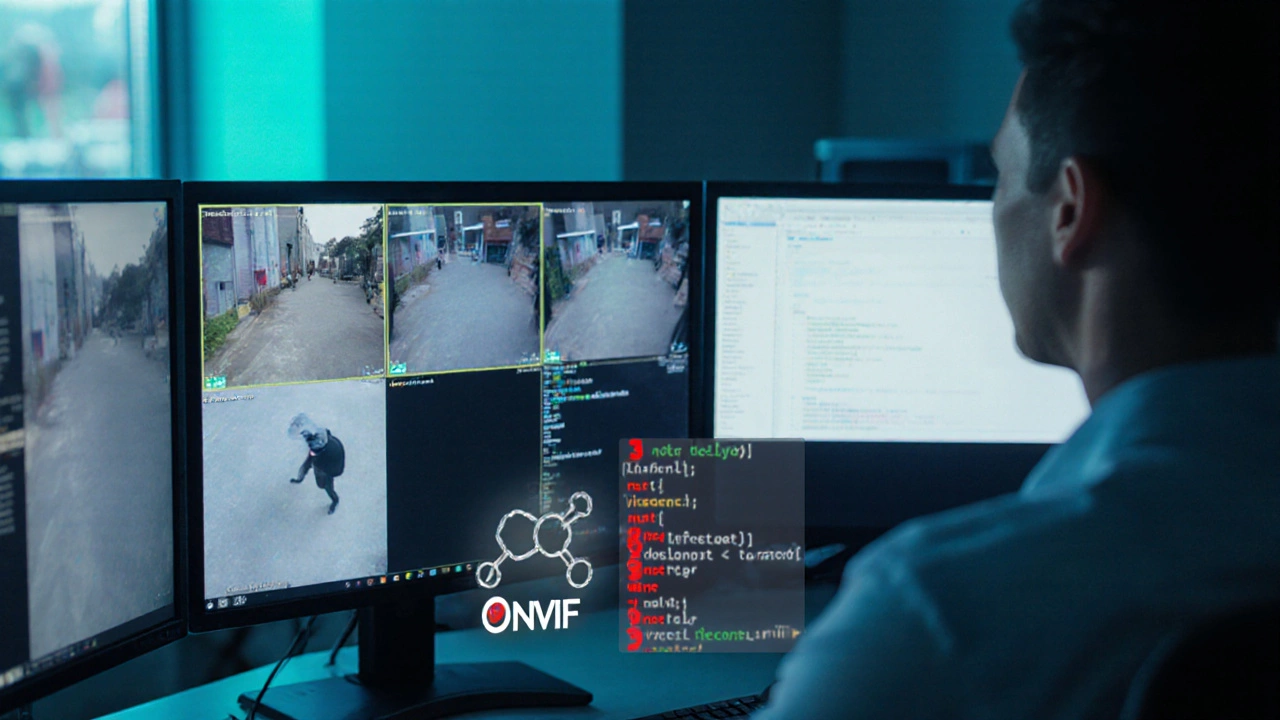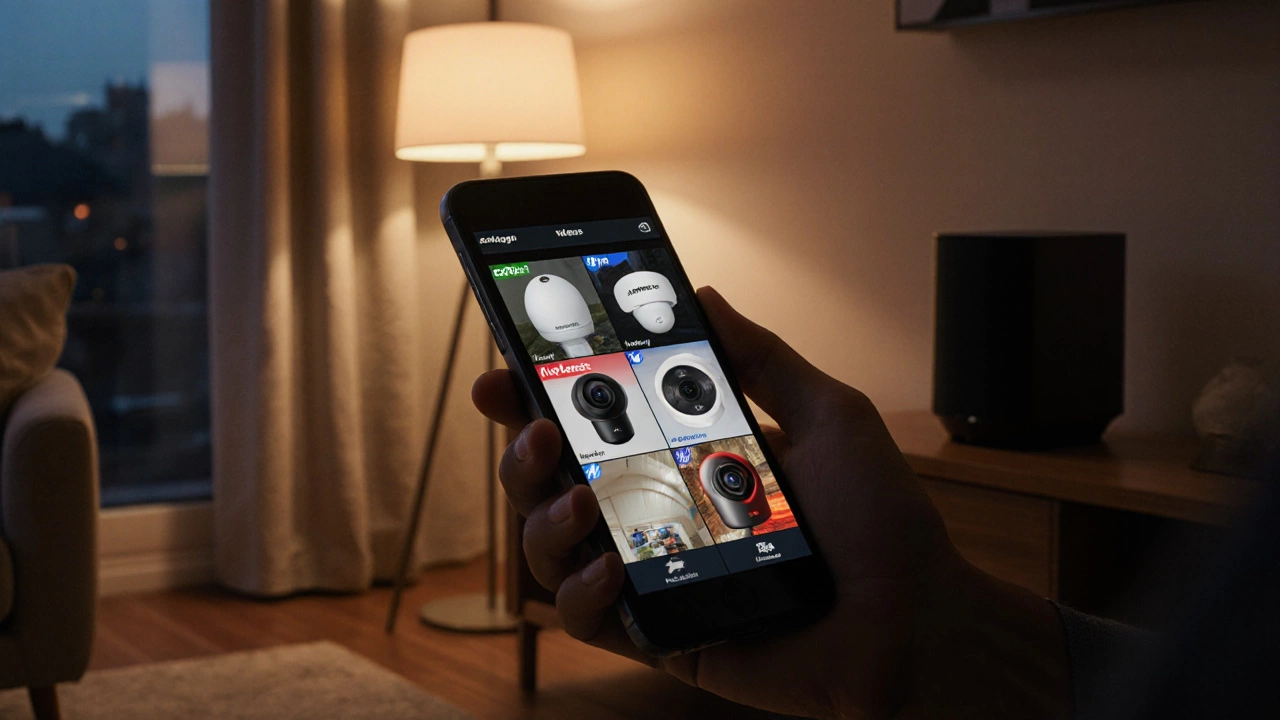Security Camera Compatibility Checker
Check Your Camera Compatibility
Enter your camera brands to see which universal apps support them and what to expect in terms of latency and features.
Your Compatibility Report
Recommended Apps
Estimated Latency
AI Features Available
Ever wondered if a single app can pull together every security camera you own, no matter the brand? The answer isn’t a simple yes or no. While a handful of apps promise "universal" support, they each come with trade‑offs that can make or break a multi‑camera setup. This guide walks you through what a universal security camera app actually is, which apps get close, where they fall short, and how to decide what fits your home.
Key Takeaways
- True 100% compatibility across all consumer cameras doesn’t exist today.
- ONVIF compliance is the closest technical bridge, but only ~47% of cameras fully support it.
- Alfred Camera, Ivideon, and Security Eye lead the pack for multi‑brand coverage.
- Universal apps typically add 15‑22% latency and lack some AI features of native apps.
- Future regulations like the EU Digital Markets Act may push manufacturers toward more open standards.
What Exactly Is a Universal Security Camera App?
In plain terms, a universal security camera app is a software platform that can connect to cameras from multiple manufacturers instead of being locked into one brand’s ecosystem. The promise is simple: one dashboard, one set of notifications, and one subscription plan for all your lenses.
The concept sprang up around 2010 when smartphones became powerful enough to stream video. Early pioneers like Alfred Systems tried to unite disparate IP streams under a single mobile interface. Since then, dozens of developers have jumped on the bandwagon, each using a mix of open standards (ONVIF, RTSP) and proprietary hacks.
How Compatibility Works - Protocols, Standards, and Limits
Most modern IP cameras speak a protocol called ONVIF. It defines how a device advertises video streams, motion alerts, and configuration settings. ONVIF has three main profiles:
- Profile S: Basic video streaming - the one most universal apps target.
- Profile G: Recording and storage.
- Profile T: AI analytics like person detection.
Unfortunately, many consumer‑grade cameras only implement a stripped‑down version of Profile S, and only about 47% of them fully support the profile. That’s why even the best‑in‑class universal apps can’t claim 100% coverage.
Beyond ONVIF, apps rely on RTSP URLs, proprietary API keys, or HTTPS endpoints. Each extra step adds configuration complexity and can break with firmware updates.

Top Multi‑Brand Apps - Who’s Getting Closest?
Below is a snapshot of the most widely used apps that market themselves as "universal" or "multi‑brand". The numbers are drawn from 2024‑2025 benchmark studies and user‑reported data.
| App | Supported Brands (approx.) |
Platforms | Avg. Latency (seconds) |
Pros | Cons |
|---|---|---|---|---|---|
| Alfred Camera | 41 (official matrix) - includes Hikvision, Amcrest, Reolink | Android 8+, iOS 14+ | 3.7 | Easy setup, strong community, 24/7 chat support | Limited native brand support, occasional RTSP failures |
| Ivideon | 120+ models - covers Hikvision, Dahua, Axis | Web, Android, iOS | 4.2 | Broad coverage, stable cloud storage | Requires specific firmware on many devices, paid support |
| Security Eye | 87 major brands - strong on Windows PCs | Windows 10+, no mobile app (mobile release Q1 2026) | 2.9 | Works with almost any IP camera, low latency on PC | Lacks mobile monitoring, UI feels dated |
| Reolink (brand‑specific) | Only Reolink hardware | Android, iOS, Web | 2.1 | Fast, full AI features, excellent UI | Zero compatibility outside Reolink ecosystem |
| Manything | Smartphone‑only (no traditional cameras) | iOS, Android | 3.0 | Turns old phones into cameras, simple cloud sync | Cannot connect to dedicated IP cameras |
Notice how even the leaders fall short of covering every brand. Alfred and Ivideon get the highest coverage numbers, but both still miss a sizable chunk of the market - especially newer consumer devices from Arlo, Nest, and certain budget models.
Performance Trade‑offs - Speed, Latency, and Features
Universal apps introduce extra layers of translation between your camera’s native protocol and the app’s unified API. Studies from TechHive (April 2025) show a consistent 15‑22% latency bump. For a live feed, that usually means a 3‑4 second delay compared with the native app’s 2‑second response.
Beyond speed, feature parity suffers. Brand‑specific apps often bundle AI analytics (people‑only detection, line‑crossing alerts) that rely on proprietary chips. Universal apps can only surface the most basic motion alerts, unless the camera itself pushes richer events via ONVIF Profile T - a rare scenario today.
Battery‑powered cameras are especially sensitive. An added 1‑second latency can cause extra wake‑up cycles, shortening battery life by up to 12% according to a 2024 i‑Tech lab test.
Real‑World Experiences - Success Stories and Common Pitfalls
Reddit’s r/homesecurity thread from October 2025 illustrates a split picture. One user managed to blend five different brands (Hikvision, Dahua, Axis, Amcrest, and a legacy Foscam) through Ivideon, but reported a 22‑second delay during motion events, making the system feel sluggish.
Conversely, a YouTube tutorial by TechWithChris (847 K views) showed how to pair a Nest doorbell with Manything’s smartphone‑camera feed via RTSP - a clever hack that works because both sides speak the same streaming protocol.
Negative feedback clusters around two themes:
- Compatibility gaps: 62% of 1‑star reviews for Alfred on Google Play mention “won’t connect to my Arlo or Nest camera”.
- Support friction: Ivideon’s paid‑tier support delays issue resolution, which annoys DIY installers on tight timelines.
Positive anecdotes focus on ease of setup (Alfred’s 3‑minute smartphone‑to‑smartphone pairing) and stability (Ivideon’s cloud‑backed streams staying alive during power outages).

Future Outlook - Regulations, Standards, and What’s Coming Next
The EU’s Digital Markets Act (effective mid‑2026) now mandates “reasonable interoperability” for security devices sold in the bloc. While the law stops short of forcing full API openness, it pushes manufacturers to support ONVIF Profile S more consistently. Expect a bump in universal‑app coverage from ~39% (2025) to perhaps 52% by 2027, according to Gartner.
On the technology side, ONVIF’s upcoming Profile T rollout aims to standardize AI event streams. If camera makers adopt it widely, universal apps could finally relay person‑only alerts - a game‑changer for low‑budget users.
However, proprietary lock‑ins remain a business strategy. Premium brands like Arlo and Nest still reserve advanced analytics for their own apps, a move analysts say will keep a portion of the market locked forever.
Decision Guide - Picking the Right App for Your Setup
Use the checklist below to match your needs with the right solution:
- Identify your camera mix. List brand, model, and firmware version. Check ONVIF compliance on the manufacturer’s specs page.
- Determine platform priority. If you need mobile monitoring on Android and iOS, rule out Windows‑only tools like Security Eye (until its mobile release).
- Assess feature tolerance. Are AI analytics essential? If yes, a brand‑specific app may be unavoidable.
- Budget constraints. Universal apps often cost less than buying multiple brand subscriptions.
- Support expectations. Choose Alfred for 24/7 chat, Ivideon if you’re comfortable with paid support.
When your checklist lines up with one of the three leaders (Alfred, Ivideon, Security Eye), you’ll likely achieve a functional, if not perfect, multi‑camera experience.
Bottom Line - Is There a Truly Universal App?
The short answer: Not yet. The long answer: You can get very close with today’s top multi‑brand apps, but expect some latency, occasional compatibility hiccups, and missing AI features. If you’re building a new system, start by choosing cameras that share ONVIF Profile S - that gives you the biggest chance of a smooth universal‑app experience. Keep an eye on upcoming regulations and ONVIF updates; they’ll push the industry toward broader openness, making the dream of a single app for every camera more attainable.
What does "universal" really mean for a security camera app?
It means the app can connect to cameras from multiple manufacturers, typically via open standards like ONVIF or RTSP, rather than being limited to a single brand’s ecosystem.
Which universal app supports the most camera brands?
As of 2025, Ivideon lists support for over 120 models, making it the leader in sheer brand count, followed closely by Alfred Camera (41 brands) and Security Eye (87 major brands).
Will I lose AI features if I switch to a universal app?
In most cases, yes. Universal apps usually only receive basic motion alerts because advanced AI (person detection, vehicle counting) relies on proprietary firmware that only native apps can decode.
How important is ONVIF compliance?
ONVIF is the key bridge. Cameras that fully implement ONVIF Profile S can be discovered and streamed by most universal apps. Without it, you’ll need manual RTSP URLs and extra setup steps.
Is there a universal app that works on both mobile and desktop?
Security Eye offers a robust Windows client and plans a mobile version for early 2026. Until then, you’ll need separate apps for desktop (Security Eye) and mobile (Alfred or Ivideon).

